初中英语语法名词知识点讲解及专项练习
- 格式:pdf
- 大小:159.25 KB
- 文档页数:11
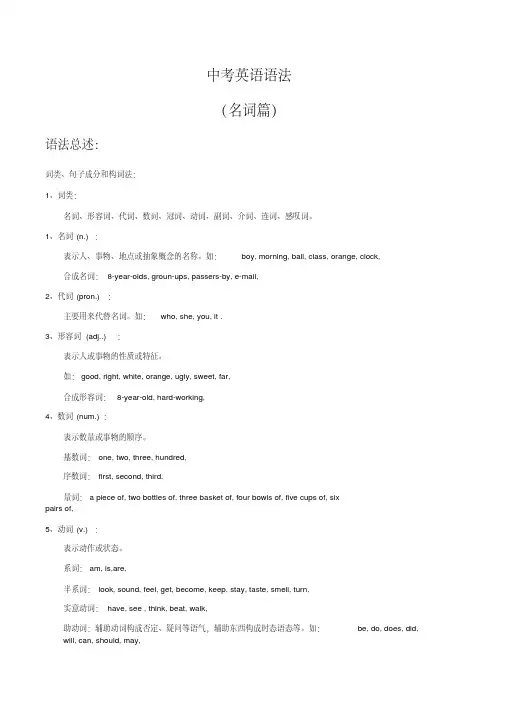
中考英语语法(名词篇)语法总述:词类、句子成分和构词法:1、词类:名词、形容词、代词、数词、冠词、动词、副词、介词、连词、感叹词。
1、名词(n.):表示人、事物、地点或抽象概念的名称。
如:boy, morning, ball, class, orange, clock,合成名词:8-year-olds, groun-ups, passers-by, e-mail,2、代词(pron.):主要用来代替名词。
如:who, she, you, it .3、形容词(adj..):表示人或事物的性质或特征。
如:good, right, white, orange, ugly, sweet, far,合成形容词:8-year-old, hard-working,4、数词(num.):表示数量或事物的顺序。
基数词:one, two, three, hundred,序数词:first, second, third,量词:a piece of, two bottles of, three basket of, four bowls of, five cups of, sixpairs of,5、动词(v.):表示动作或状态。
系词:am, is,are,半系词:look, sound, feel, get, become, keep, stay, taste, smell, turn,实意动词:have, see , think, beat, walk,助动词:辅助动词构成否定、疑问等语气,辅助东西构成时态语态等。
如:be, do, does, did, will, can, should, may,6、副词(adv.):修饰动词、形容词或其他副词,说明时间、地点、程度等。
如:now, here, often, quietly,slowly, home, upstairs, hard, very, really,7、冠词(art..):用在名词前,帮助说明名词。
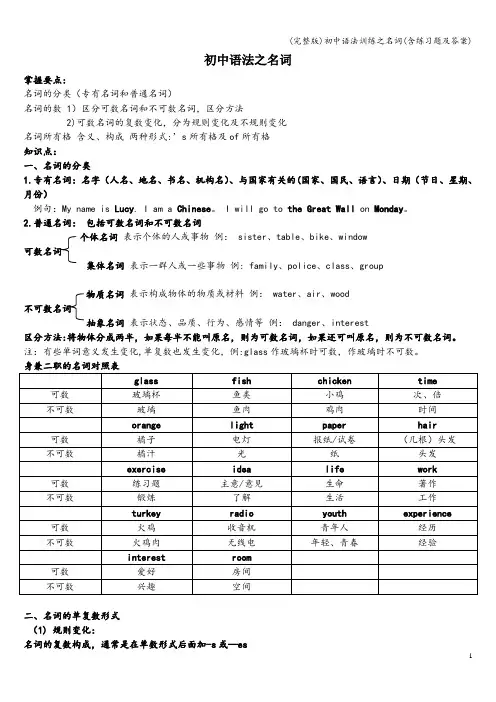
初中语法之名词掌握要点:名词的分类(专有名词和普通名词)名词的数 1)区分可数名词和不可数名词,区分方法2)可数名词的复数变化,分为规则变化及不规则变化名词所有格含义、构成两种形式:’s所有格及of所有格知识点:一、名词的分类1.专有名词:名字(人名、地名、书名、机构名)、与国家有关的(国家、国民、语言)、日期(节日、星期、月份)例句:My name is Lucy. I am a Chinese。
I will go to the Great Wall on Monday。
2.普通名词:包括可数名词和不可数名词个体名词表示个体的人或事物例: sister、table、bike、window可数名词集体名词表示一群人或一些事物例: family、police、class、group物质名词表示构成物体的物质或材料例: water、air、wood不可数名词抽象名词表示状态、品质、行为、感情等例: danger、interest区分方法:将物体分成两半,如果每半不能叫原名,则为可数名词,如果还可叫原名,则为不可数名词。
注:有些单词意义发生变化,单复数也发生变化,例:glass作玻璃杯时可数,作玻璃时不可数。
身兼二职的名词对照表二、名词的单复数形式(1) 规则变化:名词的复数构成,通常是在单数形式后面加-s或—es1、一般情况在词尾直接加s ,例 bags。
2、以s、x、sh、ch结尾的词加—es,例bus-buses box—boxes。
3、以“辅音字母+y"结尾的词,y变成i加—es 例 city-cities;以“元音字母+y”结尾的词,直接加s.4、以o结尾的除potato(马铃薯)、tomato(西红柿)、hero(英雄)加es,其余直接加s.5、以f或fe结尾的词,多数变f或fe为v加es,roof、proof直接加—s,例 life-lives wife—wives roof –roofs。
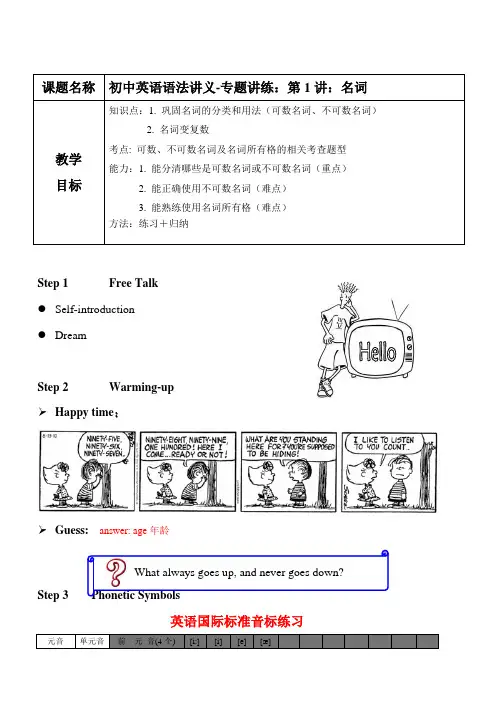
课题名称初中英语语法讲义-专题讲练:第1讲:名词教学目标知识点:1. 巩固名词的分类和用法(可数名词、不可数名词)2. 名词变复数考点: 可数、不可数名词及名词所有格的相关考查题型能力:1. 能分清哪些是可数名词或不可数名词(重点)2. 能正确使用不可数名词(难点)3. 能熟练使用名词所有格(难点)方法:练习+归纳Step 1 Free Talk●Self-introduction●DreamStep 2 Warming-up➢Happy time:➢Guess:answer: age年龄Step 3 Phonetic Symbols英语国际标准音标练习元音单元音前元音(4个) [i:] [i] [e] [æ]What always goes up, and never goes down?/i:/ bee/bi:/ feet/fi:t/ keep/ki:p/ team/ti:m/ meet/mi:t/ /i/ it /it/ big/big/ give/giv/ sick/sik/ /e/ get/get/ best/best/ help/help/ /æ/ have/hæv/ cat/kæt/语音基础小练习:下面对字母的分类是不正确的,请根据字母的发音重新归类。
[ ei ] Hh, Jj, Kk, Xx ; [ i: ] Bb, Cc, Dd, Ee, Gg, Tt, Vv, Ww; [ ai ] Aa, Ii, Yy; [ e ] Ff, Ll, Rr, Ss, Zz; [ju:] Pp, Qq, Uu, Mm, Nn, Oo;[ ei ] _______, ________, _______, ________;[ i: ] _______, ________, _______, ________,_______, ________, _______, ________; [ ai ] _______, ________;[ e ] _______, ________, _______, ________,_______, ________, _______; [ju:] _______, ________, _______;Practicing:three thousand three hundred and thirty-threeanswers:[ ei ] __Aa___, ___Hh___, ___Jj___, ___Kk___; [ i: ] __Bb__, ___Cc___, ___Dd__, __Ee__,___Gg__, ___Pp___, __Tt__, __Vv__; [ ai ] __Ii__, __Yy__;[ e ] __Ff__, __Ll__, __Mm__, _ Nn___,___Ss___, ___Xx___, ___Zz__;[ju:] __Qq __, __ Uu__, __Ww__;Step 4 Language Learning专题一:名词专有名词:首字母始终大写(人名、地名、国家、城市等)名词可数名词:有复数形式(变化规则)普通名词不可数名词:无复数形式,在句中被看作单数;借助量词表达量有生命的:’s s’ (特殊:ten minutes’ walk, one hour’s drive)名词所有格无生命的: …of…(注意顺序)可数名词可数名词是表示能够计算的人或物的名称,通常有单数和复数的形式。
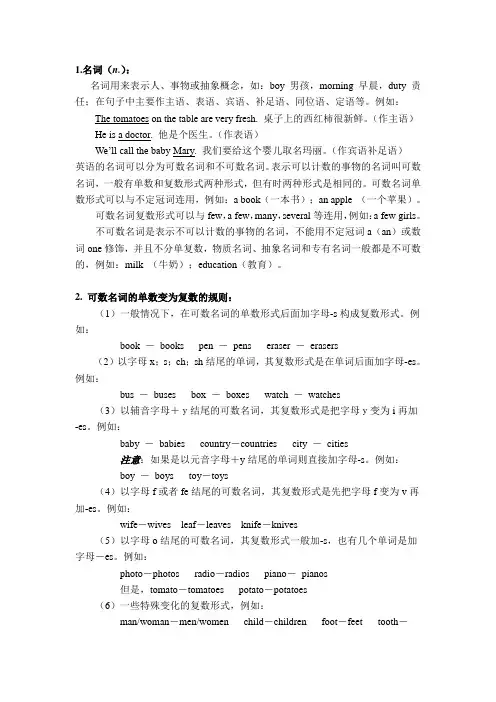
1.名词(n.):名词用来表示人、事物或抽象概念,如:boy 男孩,morning 早晨,duty 责任;在句子中主要作主语、表语、宾语、补足语、同位语、定语等。
例如:The tomatoes on the table are very fresh. 桌子上的西红柿很新鲜。
(作主语)He is a doctor. 他是个医生。
(作表语)We’ll call the baby Mary. 我们要给这个婴儿取名玛丽。
(作宾语补足语)英语的名词可以分为可数名词和不可数名词。
表示可以计数的事物的名词叫可数名词,一般有单数和复数形式两种形式,但有时两种形式是相同的。
可数名词单数形式可以与不定冠词连用,例如:a book(一本书);an apple (一个苹果)。
可数名词复数形式可以与few,a few,many,several等连用,例如:a few girls。
不可数名词是表示不可以计数的事物的名词,不能用不定冠词a(an)或数词one修饰,并且不分单复数,物质名词、抽象名词和专有名词一般都是不可数的,例如:milk (牛奶);education(教育)。
2. 可数名词的单数变为复数的规则:(1)一般情况下,在可数名词的单数形式后面加字母-s构成复数形式。
例如:book -books pen -pens eraser -erasers(2)以字母x;s;ch;sh结尾的单词,其复数形式是在单词后面加字母-es。
例如:bus -buses box -boxes watch -watches(3)以辅音字母+y结尾的可数名词,其复数形式是把字母y变为i再加-es。
例如:baby -babies country-countries city -cities注意:如果是以元音字母+y结尾的单词则直接加字母-s。
例如:boy -boys toy-toys(4)以字母f或者fe结尾的可数名词,其复数形式是先把字母f变为v再加-es。
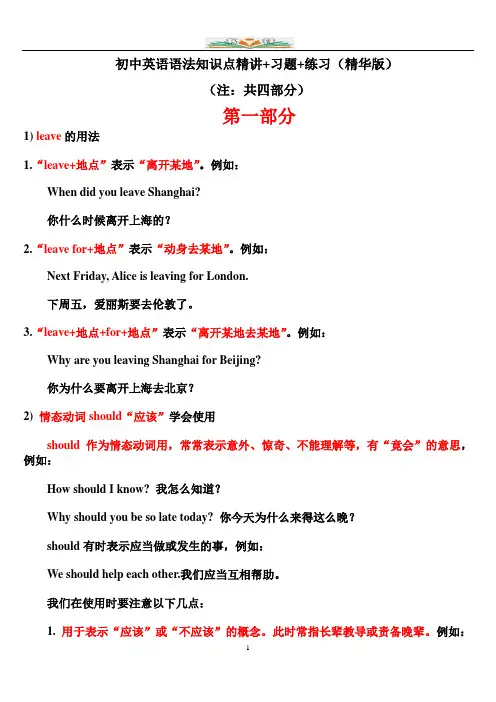
初中英语语法知识点精讲+习题+练习(精华版)(注:共四部分)第一部分1) leave的用法1.“leave+地点”表示“离开某地”。
例如:When did you leave Shanghai?你什么时候离开上海的?2.“leave for+地点”表示“动身去某地”。
例如:Next Friday, Alice is leaving for London.下周五,爱丽斯要去伦敦了。
3.“leave+地点+for+地点”表示“离开某地去某地”。
例如:Why are you leaving Shanghai for Beijing?你为什么要离开上海去北京?2) 情态动词should“应该”学会使用should作为情态动词用,常常表示意外、惊奇、不能理解等,有“竟会”的意思,例如:How should I know? 我怎么知道?Why should you be so late today? 你今天为什么来得这么晚?should有时表示应当做或发生的事,例如:We should help each other.我们应当互相帮助。
我们在使用时要注意以下几点:1. 用于表示“应该”或“不应该”的概念。
此时常指长辈教导或责备晚辈。
例如:You should be here with clean hands. 你应该把手洗干净了再来。
2. 用于提出意见劝导别人。
例如:You should go to the doctor if you feel ill. 如果你感觉不舒服,你最好去看医生。
3.用于表示可能性。
should的这一用法是考试中常常出现的考点之一。
例如:We should arrive by supper time. 我们在晚饭前就能到了。
She should be here any moment. 她随时都可能来。
3) What...? 与Which...?1. what 与which 都是疑问代词,都可以指人或事物,但是what仅用来询问职业。
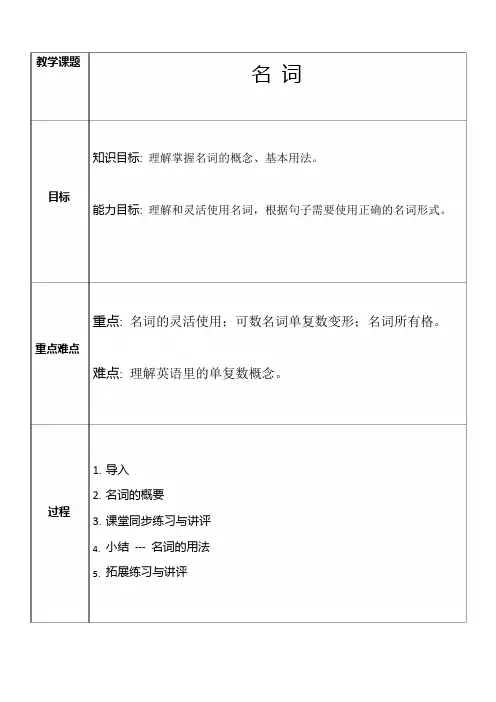
教学课题名词知识目标:理解掌握名词的概念、基本用法。
目标能力目标:理解和灵活使用名词,根据句子需要使用正确的名词形式。
重点:名词的灵活使用;可数名词单复数变形;名词所有格。
重点难点难点:理解英语里的单复数概念。
过程1.导入2.名词的概要3.课堂同步练习与讲评4.小结---名词的用法5.拓展练习与讲评专有名词名词名词意义:表示人、事物或抽象概念的词。
如:Shanghai,Lilei,desk普通名词国名地名人名可数名词不可数名词团体机构名称首字母大写个体名词表单个的人或者事物集体名词表一群人或一些事物的总称抽象名词表无法分为个体的物质物质名词表抽象概念的词如:Jim,June,China,Harbin.teacher,apple…family,police…water,money…health,friendship…1.可数名词(个体名词和集体名词):有单复数之分A.不规则变化常见的有:单复数同型:man-men,woman-women,foot-feet,tooth-teeth,child-children,mouse-mice... Chinese Japanese people sheep deer fish(中日友好永不变)a Chinese---two Chinese;a Japanese--- four Japanese(英法联盟a变e)an English--- eight Englishmen;an Frenchman---nine Frenchmen (其他后面加s)a German---five GermansB.规则变化情况一般的词以s,sh,ch,x结尾以0结尾以辅音+y结尾以f/fe结尾构成+s+es有生命,+es;无生命,+s改y为i+es改f为v+es例词day-days desk-desksmatch-matches boss-bossestomatoes,potatoes,heroesbaby-babies fly-flieswife-wives leaf-leavesphotos,kilos, 1. Some ____ and ____ will come to visit our school next month.A. Germans; EnglishmansB. Germen; EnglishmenC. Germans; EnglishmenD. German; Englishman2.Look! There are three ______ and two ______ at the school gate. Let ’s show them around our school.A. Frenchman; GermanB. Frenchmen; GermanC. Frenchmen; GermansD. Frenchmans; Germans写出下列名词的复数形式1piece shoe orange lake23456789busbodyboylifezootomatomanGerman foxcitykeyleafpianoherowomanChinese glassenemyholidayyourselfradiotoothfishermanchild wishbabywaywolfphotofootapplesheepC.复合名词的复数变化规则: man 和 woman 都要变 girl 和 boy 却不变1 men doctors boy students 1. They are________.2women drivers girl football playersA.man doctorB.men doctorsC.men doctorD.man doctorsD.常考可数名词knifesecond chance size decisionvoicestomachacheminute mistake shape invitationtastetoothachequarter question invention concertsmellcoldhour problem discovery playexpressionfeverweek idea message ticketintroductioncoughyear suggestion difference sightcelebration1.If you work harder, you'll have another_________ to play the violin at a concert.A. sleepB. chanceC. mistakeD. problem2.-Lily, could you please pass me the_________? I want to cut the apple.-Sure, here you are. A. pen B. pencilC. bookD. knifeE.常见复数标志all/both基数词two...many/someseveral几个a few/fewotherthese/thosedifferentare/were在一般现在时的条件下,遇到复数名词,或代词,动词用原形:we all come from China.1.Those white socks____small.A.areB.isC.amD.do2.How many_____do they have?A.pictureB.picturesC.a picture3.We are_____,but they are________.A.Germans;JapaneseB.Germen;JapaneseC.Germans;JapanesesD.Germen;Japanese4.__________turn green in spring.A.LeafB.LeavesC.LeaveD.Leafs5.Look!The kites in the sky are in different_____.Some are big and some are small.A.sizeB.sizesC.colorD.colors6.I can see some________on the hill.A.sheeps and deersB.sheep and deerC.sheeps and deerD.sheep and deers2.不可数名词(1)不可数名词没有复数形式,不能与a/an或具体数字连用,但特指某物时可以与定冠词the连用。
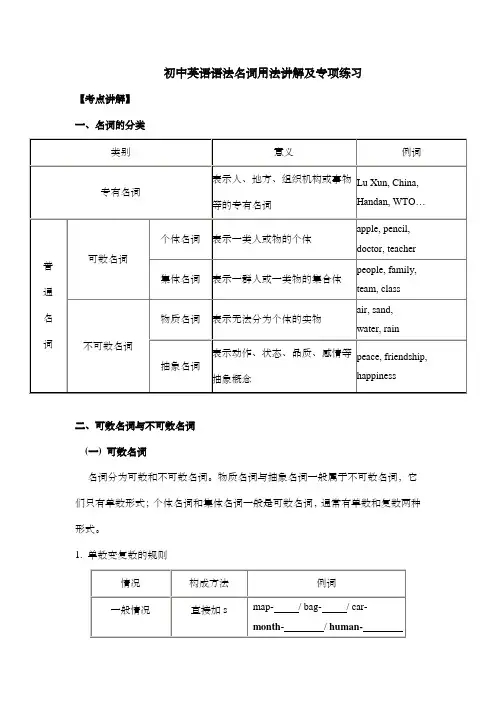
初中英语语法名词用法讲解及专项练习【考点讲解】一、名词的分类二、可数名词与不可数名词(一) 可数名词名词分为可数和不可数名词。
物质名词与抽象名词一般属于不可数名词,它们只有单数形式;个体名词和集体名词一般是可数名词,通常有单数和复数两种形式。
1. 单数变复数的规则【注】 ① 常见的以o 结尾要加es 的有如下几个:hero, tomato, potato ,可记为“英雄爱吃西红柿和土豆”。
剩余以o 为结尾的加s :如photo, zoo, piano等② 以f 或fe 结尾变f 或fe 为v+es 的词有如下:小偷的妻子用刀把狼劈成两半,一半放在书架上,一半放在树叶上2. 不规则复数形式(1) 元音或词尾发生变化:child- , man- , woman-_________, foot- , tooth- , mouse-policeman -___________, Frenchman-_________Englishman-(2) 单复数形式相同: (3) 形式为复数,意思为复数:people ,police(4) 形式为复数,意思为单数:news, maths, physics(5) 只能用复数形式:trousers, shoes, glasses ……【注】○1man,woman作定语修饰别的名词时,要把man,woman和其他部分都变成复数,如man teacher –,woman doctor –_____________;○2但是其他合成名词,只需把其中心词变成复数形式。
如:shoe factory- , banana tree-3. “某国人”的复数形式“中日不变英法变,其余s加后边”(二)不可数名词不可数名词包括物质名词和抽象名词,一般没有复数形式1. 物质名词有water, rice, tea, milk, chicken(鸡肉), fish(鱼肉), food, fruit, beef,orange(橙汁), sugar, salt, paper(纸), porridge, bread, sand, juice,chalk等;抽象名词有news, music, time(时间), information等;2. 在英语中,不可数名词如果要表示“量”的概念,可以用以下两种方法:(1) 用much, a little, a lot of/lots of, some, any等表示多少,例如:a lot of money / some milk / any water / much snow(2) 用“a piece / glass / cup / bottle / bag of+不可数名词”或“数词pieces /glasses / cups / bottles / bags of+不可数名词”这类定语,例如:a piece of paper ( wood / bread) →a bottle of orange →a glass of wate r →a cup of tea →a bag of rice →3. 不可数名词不能与数词或不定冠词a/an连用;4. 注意有些名词既可作可数名词,也可作不可数名词,此时中文意思有区别。
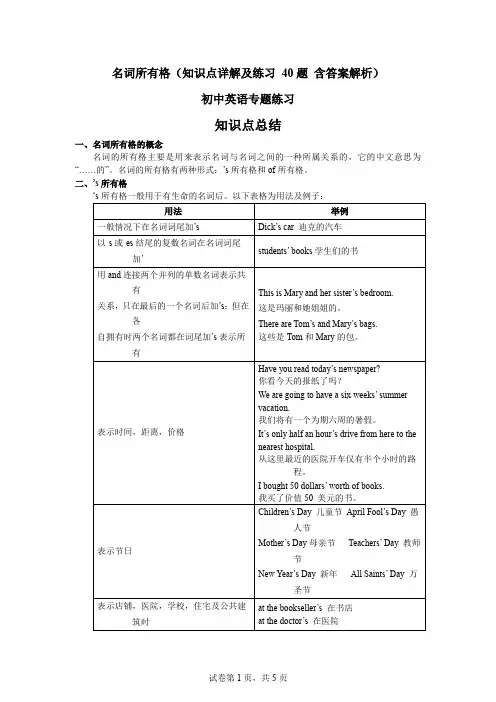
名词所有格(知识点详解及练习40题含答案解析)初中英语专题练习知识点总结一、名词所有格的概念名词的所有格主要是用来表示名词与名词之间的一种所属关系的,它的中文意思为“……的”。
名词的所有格有两种形式:’s所有格和of所有格。
二、’s所有格三、of所有格“of+名词”一般用来表示无生命的物体间的所属关系,如:the color of the window窗户的颜色the brake of the bicycle自行车闸the frame of the photo相框the title of the article文章标题注意:在许多情况下,表示人、动物、集体、时间、机构、组织等的名词都可以用of 所有格代替’s所有格。
例如:the sunshine of autumn = autumn’s sunshinethe debate of Sunday = Sunday’s debatethe government’s decision = the decision of the government但是,在表示类别时’s所有格一般不能用of所有格代替。
例如:men’s suits 不能改为the suits of mena doctor’s degree不能改为the degree of a doctor四、双重所有格“of+名词所有格”或“of+名词性物主代词”通常用来表示整体中的一个或部分,如:a friend of Mike’s = one of Mike’s friends麦克的一个朋友a classmate of Mine = one of my classmates我的一个同学【重难点】1. 表示几个人共有一个物体,在最后一个名词词尾加-’s,如:Tony and Tommy’s room is not very big.托尼和吉姆的房间不是很大。
(表示共有)2. 表示几个人各自所有,在每个名词词尾都加-’s,如:Jane ‘s and Lily’s mothers are both teachers.简的妈妈和莉莉的妈妈都是老师。
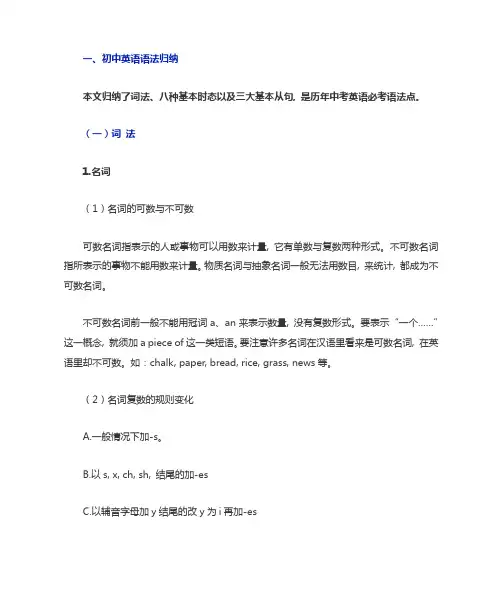
一、初中英语语法归纳本文归纳了词法、八种基本时态以及三大基本从句, 是历年中考英语必考语法点。
(一)词法1.名词(1)名词的可数与不可数可数名词指表示的人或事物可以用数来计量, 它有单数与复数两种形式。
不可数名词指所表示的事物不能用数来计量。
物质名词与抽象名词一般无法用数目, 来统计, 都成为不可数名词。
不可数名词前一般不能用冠词a、an来表示数量, 没有复数形式。
要表示“一个……”这一概念, 就须加a piece of这一类短语。
要注意许多名词在汉语里看来是可数名词, 在英语里却不可数。
如:chalk, paper, bread, rice, grass, news等。
(2)名词复数的规则变化A.一般情况下加-s。
B.以s, x, ch, sh, 结尾的加-esC.以辅音字母加y结尾的改y为i再加-esD.以f, fe结尾的, 去掉f或fe, 变成v再加-es(3)名词的所有格A.单数名词词尾加’s, 复数名词词尾若没有s, 也要加’s。
如: the worker's bike, the Children’s ballB.表示几个人共有一样东西,只需在最后一个人的名字后加.s若表示各自所有,则需在各个名字后.s。
如: This is Lucy and Licy’s room.These are Kate's and jack’ s rooms.C.如果是通过在词尾加—s构成的复数形式的名词, 只加’。
如: the students’books, the girls’blouses(另外: 名词+of+名词名词是有生命的, 我们就用’s结构来表示所有关系。
如果名词所表示的事物是无生命的, 我们就要用名词+of+名词的结构来表示所有关系。
)2.代词人称代词, 物主代词, 反身代词, 指示代词, 不定代词(1)人称代词第一人称单数I me my mine myself复数 we us our ours ourselves第二人称单数 you you your yours yourself复数 you you your yours yourselves 第三人称单数 he him his his himselfshe her her hers herselfit it its its itself复数 they them their theirs themselves (2)物主代词物主代词的用法: 形容词性物主代词后面一定要跟上一个名词;名词性物主代词可作主语、表语、宾语。

【名词】一、名词(n.) 表示人、事物或抽象概念的名称的词( 一) 名词的分类名词分为普通名词和专有名词,其中普通名词包括可数名词和不可数名词,可数名词可用作单数,也可用作复数。
可数名词包括个体名词( 表示一类人或物的个体。
如:boy ,desk ,cat ,window) 和集体名词( 由若干个体组成的集合体。
如:family ,class ,police) 。
不可数名词包括物质名词( 表示无法分为个体的实物。
如:water ,paper ,silk ,money)和抽象名词( 表示性质、行为、状态、感情或其它抽象概念。
如:work ,happiness ,music ,difficulty ,housework)专有名词表示个人、地方、机构、组织等。
如:Tom ,the Great Wall ,the Spring Festival ,France ,the United States)( 二) 名词的数1 .可数名词有单数和复数两种形式,其复数形式的构成主要有以下几种:(1) 一般情况下,在词尾加s 。
eg .book ——books ,dog ——dogs ,pen ——pens ,boy ——boys以轻辅音结尾的名词后的s 的读音为[s) ,以浊辅音和元音结尾名词后的s 读音为〔z〕。
(2) 以s ,x ,ch ,sh 结尾的词名词变复数时,要在词尾加es 。
eg .beach ——beaches ,brush ——brushes ,bus ——buses ,box —boxes(es 读音为〔iz〕(3) 以“辅音字母+y ”结尾的名词,先变y 为i ,再加es 。
eg .city ——cities ,family ——families ,documentary ——documentaries ,country ——countries ,strawberry ——strawberries(ies 读音为[iz])( 注:以“元音字母+y ”结尾的词,直接在词尾加-s 。

中考英语之名词知识点详解及练习Revised by Jack on December 14,2020名词考纲要求:1.可数名词的单复数,注意其不规则变化。
2.名词量的表示方法,特别是不可数名词量的表达方式3.名词的所有格,辨析其两种不同的形式。
4.在具体的语境中正确辨析名词词义。
命题规律:名词(n.):表示人、事物、地点或抽象概念的名称。
如:boy, morning, bag, ball, class, orange, happiness.第一节.名词的分类名词分为专有名词和普通名词。
1.普通名词又可分为:(1)个体名词。
如:cup,desk,student等。
一般可数,有单复数形式。
(2)集体名词。
如:class,team,family等。
一般可数,有单复数形式。
(3)物质名词。
如:rice,water,cotton等。
一般不可数,没有单复数之分。
(4)抽象名词。
如:love,work,life等。
一般不可数,没有单复数之分。
2.专有名词:如:China,Newton,London, Lu xun 等。
第二节.名词的数名词有可数名词和不可数名词之分。
而可数名词又有单数和复数之分。
我们要表达两个或两个以上数的概念时,该名词就要用复数形式。
可数名词的复数形式构成有两种:1. 规则变化巧学妙记2.不规则变化①外部变化:child→children, ox→oxen②内部变化:foot→feet, tooth→teeth, mouse→mice, man→men, woman→women单复数同形:Chinese,Japanese,sheep,deer,fish等。
但当fish表示不同种类的鱼时,可以加复数词尾。
③集体名词,以单数形式出现,实为复数:people, police等本身就是复数,不能说a people, a police. the English, the British, the French, the Chinese, the Japanese, the Swiss等名词,表示国民总称时,作复数用。
初中语法讲解名词及练名词习题(含答案)一、名词的分类:名词分为专有名词和普通名词。
1、专有名词:个人,地方,机构等专有名称,如:China, Shanghai, Li lei 等。
专有名词的首字母通常要大写。
具体说来,它包括人名、地名、月份、星期、节日、书名、电影名以及某些抽象名词等。
如:Jim吉姆China中国July七Friday 星期五Christmas 圣诞节English 英语2、普通名词:指表示一类人或东西或抽象概念的名词。
1)个体名词:某类人或东西中的个体,如fighter, gun, country,cup, desk, student等。
一般可数,有单复数形式。
2)集体名词:若干个体组成的集合体,如family, team, police, class等。
一般可数,有单复数形式3)物质名词:无法分为个体的实物,如cotton,tea, air等。
一般不可数,没有单复数之分。
4)抽象名词:动作, 状态, 品质, 感情等抽象概念. 如health, happiness,love, work, life等。
一般不可数,没有单复数之分。
二、名词的数:可数名词都有单数和复数之分;不可数名词没有复数形式。
【重点】1、规则的可数名词的复数变化规则:1)一般情况加–s :books,mouths,houses,girls等。
2)以s,sh,ch,x结尾的加–es:classes,boxes,matches 等。
3)辅音字母+ y结尾的变y为ies:cities,countries,parties,factories等。
4)以o 结尾的词+es:heroes,Negroes,tomatoes,potatoes等。
以o 结尾+s:radios,zoos,bamboos,pianos,kilos,photos 等。
5)以f,fe 结尾的多数+es:leaves,lives,wives,knives,halves,wolves等。
名词语法讲解及练习题分类及用法名词语法讲解及练习题分类及用法名词是表示人,事物,地点或抽象概念的名称的词,名词的语法知识分为几种。
下面店铺为大家带来名词语法讲解及练习题,欢迎大家学习!名词语法讲解:名词复数的规则变化名词语法讲解:其它名词复数的规则变化1) 以y结尾的专有名词,或元音字母+y 结尾的名词变复数时,直接加s变复数。
例如:two Marys the Henrysmonkey---monkeys holiday---holidays2) 以o 结尾的名词,变复数时:a. 加s,如: photo---photos piano---pianosradio---radios zoo---zoos;b. 加es,如:potato--potatoes tomato--tomatoesc. 上述a和b两种方法均可,如zero---zeros / zeroes。
3) 以f或fe 结尾的名词变复数时:a. 加s,如: belief---beliefs roof---roofssafe---safes gulf---gulfs;b. 去f,fe 加ves,如:half---halvesknife---knives leaf---leaves wolf---wolveswife---wives life---lives thief---thieves;c. 上述a和b两种方法均可,如handkerchief: handkerchiefs / handkerchieves。
名词语法讲解:名词复数的不规则变化1) child---children foot---feet tooth---teethmouse---mice man---men woman---women注意:由一个词加 man 或 woman构成的合成词,其复数形式也是-men 和-women,如an Englishman,two Englishmen。
中考英语名词讲解及练习名词表示人、事物、地方、现象或抽象概念等的名称的词.一、名词的分类名词类别意义例词专有名词表示具体的人名、事物、国家、地名、机构、团体等的专有名称jim,china,qingdao,theuk,thegreatwall普通名词可数名词个体名词表示单个人的人或事物girl,student,factory,desk,cat,country集合名词表示一群人或一些事物的总称people,police,team,clothes,group,crew不可数名词物质名词表示无法分为个体的物质water,ice,pork,cheese,cotton,broccoli抽象名词表示抽象概念的词fun,healthy,happiness,courage,love,care注:1.专有名词是指人、地方、团体、机构等特有的名称.第一个字母必须大写.专有名词前一般不加冠词.2、由普通名词构成的专有名词前要用定冠词“the”,但它不大写.3、有些不可数名词有时表示为具体的东西时,则变为可数名词,eg.beer----abeer,work---aworkglass---aglass,room---aroom二、名词的数:表示可以计算数目的人或物称为可数名词.1、可数名词有单、复数两种形式:可数名词的单数形式要在名词前加“a或an”;复数形式是在名词后加“-s或-es”.名词复数形式有规则变化和不规则变化两种,规则变化及其读音可依照下表:当名词为:词尾变化读音例词一般情况加s 在清辅音后读/s/jeeps,pats,clocks 在浊辅音或元音后读/z/boys, sofas,drawers以s,x,ch,sh结尾的单词加es/iz/watches,boxes,classes,brushes以字母o结尾的单词加s或es/z/zoos,photos,bamboos,tomatoes,potatoes,heroes,以辅音字母+y结尾的单词去y变i加es/z/dictionaries,strawberries,以f或fe结尾的单词去f或fe变v加es/vz/leaves,wives,halves以th结尾的词加s/ez/;/θz/mouths,paths;months,2.可数名词复数的不规则变化①改变单数名词中的元音字母eg.man--men,woman—women,tooth—teeth,foot—feet,mouse--mice②单复数同形eg.chinese-chinese,deer-deer,fish-fish,sheep-sheep,…③由man和woman构成的合成词,每个名词都要变复数eg.amandoctor—mendoctors,awomanteacher--womenteachers注意:有些名词表示一种物体具有不可分割的相同的两部分,在使用时只有复数形式eg.trousers,clothes,glasses,shorts,etc;有些名词从形式上看是复数,实际上是单数其后的谓语动词要用单数. eg.maths,phyiscs,politics,news3.不可数名词:表示不能计算数目的人或物,称为不可数名词.他们前面不能用a/an,没有复数形式.物质名词和抽象名词都属于不可数名词.不可数名词一般只有单数形式,但有其特殊用法:1同一个词,变成复数形式,意义不同.eg.food食物---foods,time时间---times,green绿色---greens青菜2有些不可数名词用复数代指具体的事物eg.hope---hopes希望hardship---hardships艰苦3物质名词在表示数量时,常用某个量词+of来表示eg.acupoftea,sevenpiecesofbread,severalbagsofrice,…例题解析:举一反三,学的更轻松1.theygotmuch_____fromthosenewbooks.a.ideasb.photosc.newsd.stories2.Ihavetwo_______andthreebottlesof_________here.a.orange,orangeb.oranges,orangesc.oranges,oranged.orange,oranges3.EveryeveningEr.kingtakesa_________tohishome.a.25minutes’walkb.25minute’swalkc.25minutewalkd.25minuteswalk4.Anold_______wantstoseeyou.a.peopleb.personc.thepeopled.theperson5.Helpyourselfto__________.a.chickensandapplesb.chickensandapplec.chickenandappled.chickenandapples6.Oh,dear.I forgotthetwo_________.a.room’snumberb.rooms’numberc.roomnumbersd.rooms’numbers7.ShehasbeeninTianjinfortenyears.Tianjinhasbecomehersecond_____ ____.a.familyb.housec.homed.room8.________motherscouldn’tgototh emeeting,becausetheyhavegonetos hanghai.a.M aryandpeter’sb.Maryandpeterc.M ary’sandpeterd.M ary’sandpeter’s9.LiLeihasbeento__________manytimesthismonth.a.heruncleb.heruncle’sc.herunclesd.aunt’s10.H eisasuccessasaleaderbuthehasn’t________inteaching.a.manyexperiencesb.muchexperiencec.anexperienced.alotexperience练习与巩固:熟能生巧,取得好成绩选择最佳答案:1.Lastnight,therewasafoodaccident.the_______wereill,butno_____ __werelost.a.child,livesb.children,lifec.children,livesd.child,life2.---Thisisaphotoof_________whentheywereyoung.---ok,Howhappytheybothlookeda.myfatherandmotherb.mymotherandfather'sc.mymother'sandfather'sd.myfather'sandmymother3.Thenewstudentisin__________,gradetwo.a.classthirdb.thirdclassc.classthreed.threeclass4.Todayisseptember10th.it's__________day.let'sgoandbuysomeflowe rsforourteachers.a.teachersb.teachers'c.theteachers'd.teacher's5.Themarketisn'tfarfromhere.it'sonly_________bicycleride.a.halfanhours'b.halfanhour'sc.halfanhourd.anhourandahalf6.---Whatwouldyouliketodrink,girls---_________,please.a.twocupofcoffeeb.twocupsofcoffec.twocupsofcoffeed.twocupsofcoffees7.Duringchristmas,peoplegettogetherandsingchristmassongsfor____ _____.a.funb.wishesc.interestd.thanks8.Some_________areflyingkitesneartheriver.a.childb.boyc.boysd.childs9.Aftertheexam,we'llhave________holiday.a.twoweeksb.two-weeksc.twoweeks'd.twoweek's10.Theyarethose_________bags.pleaseputthemonthebus.a.visitorb.visitorsc.visitor'sd.visitors'11.---Howmanyworkersarethereinyourfactory---Therearetwo___________.a.hundredsb.hundredc.hundredofd.hundredsof12.---whatdoyouthinkofthe_______themoonlightsonatabybeethoven ---Itsoundsreallywonderful.a.subjectb.musicc.bookd.animal13.Thereisnotenough_________inthecornerforthefridge.a.placeb.roomc.fieldd.ground14._________comesfromsheepandsomepeoplelikeeatingita.woolb.porkc.muttonk15.ifyoudon'ttakemore________,you'llgetfat.a.medicineb.lessonsc.photosd.exercise16.myschoolisabouttwenty________walkfromhere.a.minuteb.minutes'c.minutes'sd.minutes17.mum,ihave_______totellyoua.agoodnewsb.somegoodnewsc.somegoodnewesd.muchgoodnews18.whichisthe________tothepostofficea.streetb.wayc.roadd.address19.istayedat________lastsunday.a.myunclesb.myuncles'c.myuncle'sd.myuncle'sfamily20.maths________noteasytolearn.a.areb.isc.amd.were冠词冠词分为不定冠词a,an和定冠词the知识梳理:提纲挈领,抓住重点和难点一、不定冠词的用法1用与可数名词的单数形式前,指人或事物的某一种类:例如:Sheisagirl.Passmeanapple,please.2、指某人或某物,但不具体说明何人或何物.例如:AboyiswaitingforyouWeworksixdaysaweek.3.表示“一”这个数量,但数的概念没有one强烈.例如: wearegoingtohaveanEnglishlessontomorrow.Ihaveamouth,anose,twoeyesandtwoears.4.用于某些固定的词组中.例如:afew,alittle,alotof注:用a还是an,要看后面的词读音以辅音开头还是以元音开头.二、定冠词的用法1特指某些人或某些物.例如:thephotooftheboy2指双方都知道的人或物.例如:-Wherearethenewbooks,jim-Theyareonthesmalltable.3指上文提过的人或物.例如:Todayheismakingamachine. Hewantstoridethemachinelikeabikeandflyitlikeaplane.4.用在世界上独一无二的事物前.例如: Thesunisbiggerthanthemoon.5.用在序数词或形容词最高级前.例如: Thefirsttruckiscarryingafewbaskets.Thethirdoneiscarryingthefewestofall.6.用在由普通名词构成的专有名词前.例如:ThegreatwallThenorthstreethospital7.用在一些习惯用语中.例如:inthemorningafternoon,evening,ontheleftrightattheendof三、不用冠词的情况1在专有名词前和不可数名词前.例如:china,gradetwo,billsmith,milk2名词前已有作定语用的this,that,my,your,some,any等代词.例如:theletterisinherpocket.Ithinktheshopisclosedatthistimeofday.3复数名词表示一类人或事物时.例如:myfatherandmotherareteachers.Ilikecakes.4在星期、月份、季节、节日前.例如:Itissundaymonday,tuesday,etc.Todayismid-autumnday.Itiscoldinwinter.5在称呼语或表示头衔的名词前.例如:Unclewanglikesmakingthings.WhatcolourareM rsgreen’sshoes6在三餐饭和球类运动的名称前.例如:Hewenttoschoolafterbreakfast.Canyouplaybasketball注:在某些固定词组中,如:athome,bybus,gotoschool等的名词前不用冠词.冠词用法口诀一、定冠词的用法.特指双熟悉,上文已提及;世上独无二,序数最高级;某些专有名,习语及乐器.以上口诀归纳了用定冠词的一般情况,即:①特指某些人或物②谈话双方都熟悉的人或事③上文已经提到的人或事④世界上独一无二的事物前⑤序数词回形容词最高级前⑥某些专有名词前⑦一些习惯短语如:intheday等中和乐器前如:playtheviolin/piano.二、不用冠词的集中情况.下列情况应免冠,代词限定名词前;专有名词不可数,学科球类三餐饭;复数名词表泛指,两节星期月份前;颜色语种和国名,称呼习语及头衔.以上口诀主要概括了一般应“免冠”的几种情况,即:①名词前已有作定语用的this、that、some、any、my等限定词.②专有名词和不可数名词前.③表示学科的如:maths、chinese、physics名词前.④球类活动的名词前及三餐总称前.⑤复数名词表示泛指一类人或事时.⑥节日、季节、星期、月份前.⑦表示颜色如:it'sred/yellow.、语种如:speakenglish/japanese和国家的非全称名词如:weliveinchina.theycomefromamerica..⑧在称呼或表示头衔的名词前.⑨某些习惯短语中如:inbed、gotoschool等.例题解析:举一反三,学的更轻松1._______milkisfood.________milkinthiscuphasgonebad.2.---Doyoulikeplaying_________football---yes.butihaveonly_________basketball.3.Doyouknow_______girlon________anothersideof________lake4.T here’s________“u”and________“s”in________work“use”.5.S hesays________animalscant’slivewithout__________air,either.6.Hisfather,whois________honestman,isteachingin________universi ty.7.Whichisheavier,________elephantor________horse8.________coldwindwasblowingfromthenorth.9.Heisalwaysreadytohelp_________oldand________young.10.________greensaretravelingin_________southchina.11.Although________mostofusliketodrinkbeer,thosewhodrink_______ _mostare_______leasthealthy.12.Xiaomeisaw_________interestingfilmlastnight.________filmwasa bout_________kinddoctor.13.T omwentto_________schoolasusual,buthedidn’tknowhisfatherwen tto________schoolforaparentmeeting.15.________knowledgebeginswith_________practice.。
名词的用法机场工作人员问:Who are you flying with?(你坐哪家航空公司?)我答:Myself。
对方大囧,一笑之后补充:Which airline?An airport staffer asked me "Who are you flying with?" and I said "Myself." He was surprised and then laughed, adding "Which airline?"原来Who在英语里也可以泛指航空公司等群体或组织。
"Who" in English can also refer to a group or an organization such as airlines.C-名词单复数普通名词指一类人或事物的名称。
英语中普通名词分为可数名词和不可数名词。
可数名词一般有单、复数两种形式。
不可数名词之前不可直接用泛指限定词和数词。
(一)可数名词及其复数形式(1)可数名词的复数形式一般由词尾加-s或-es构成,其规则见下表:类别构成法读音例词一般情况加-s 在清辅音后读/s/ maps, books这类集合名词包括baggage/luggage(行李),clothing(衣服),furniture(家具),machinery(机器),poetry(诗),scenery(风景),jewelry(珠宝),equipment(设备)等, 其用法特点为:是不可数名词,只用单数形式,不用不定冠词(当然更不能用数词),没有复数形式。
如:Our clothing protects us from[against]the cold. 我们的衣服可以御寒。
Have you checked all your baggage? 你所有的行李都托运了吗?第五类补充几个常考的集合名词除上面提到的四类集合名词外,以下几个集合名词也应重点注意(因为它们也是常考考点):1.hair(头发,毛发):指全部头发或毛发时,为集合名词(不可数);指几根头发或毛发时,为个体名词(可数)。
中考英语语法复习—名词名词部分的考查重点为:1、名词的可数与不可数性。
2、名词单复数在特定情况下的使用。
3、名词的普通格与所有格作定语的选用。
4、物质名词、抽象名词具体化。
名词词义的区别与固定搭配。
【考点诠释】一、名词的各种分类。
单、复数的用法及单数名词变复数名词的方式,包括可数名词的复数的变化规则,少数不规则名词的复数形式及部分单复、数同形的名词。
【考例】There is good_________ for you. I've found your lost watch.A. newsB. ideasC. messagesD. thoughtsMy uncle will come to my house for dinner.I want to buy some ___to make a vegetable salad for him.A.meat B.tomatoes C.apple juice The teacher said we needed to choose three for the school concert.A. farmersB. doctorsC. driversD. singersAt night the koala bear gets up and eats___________.A.1eaf B.1eaves C.leafsThe PLA man saved three ____lives in the accident.A.children’s B.children C.child D.childs' Come on,children.Help yourselves to some_________ if you like.A.fish and chicken B.fishes and chicken C.fish and chickens D.fishes and chickensAll the ____teachers enjoyed themselves on March 8th,because it was their own holiday.A.man B.men C.womanD.women二、不可数名词数量的表达法。
英语语法名词1.名词是生物,事物,地方以及抽象概念的名称,如:Ben(班),cat(猫),pen(钢笔),London(伦敦),time(时间)等。
2.名词可分为可数名词和不可数名词。
可数名词1.可数名词有单复数之分,前面可加数词或冠词,如:boy(男孩),book(书),class(班级),family(家庭)。
2。
可数名词包括普通名词,集合名词和少数专有名词.【参见不可数名词】普通名词1。
普通名词包括生物,事物,地方等的名称,单位名称和有限定并可算其次数的名词,即可和take或have连用表示动作的与动词同形的名词,如:boy(男孩),office(办公室),idea (主意),book(书),mile(英里),(have) a look(看一看),(take) a walk(散步)等。
2。
普通名词受代名形容词或所有格修饰时,不再加冠词,如:this(my,our,every,each,John's)book.3.复数普通名词可用many,few,a few,a lot of等修饰;不用much,little等修饰.【参见集合名词】集合名词1.集合名词是表示由若干个体组成的集合体的名称,如:family(家庭),class(班级),police (警察),cattle(牛),clothing(衣服),jewelry(珠宝)等。
2.集合名词指整体时被看作单数名词;集合名词指整体的构成分子时被看作复数名词。
Her family was very poor.她家很穷。
My family are all here。
我的家人都在这里。
3.集合名词用many,few,a few,a lot of等修饰,不用much,little修饰。
【参见普通名词,名词的数,主谓一致】不可数名词1。
不可数名词是因不能数而无单复数之分的名词,一般用no,any,some,little,much等修饰,如:food(食物),truth(真相)等。
初中英语语法名词知识点讲解及专项练习1.可数名词的复数变化1) 规则变化(1) 大多数都直接在名词后加-s。
(2) 以-s , -x , -ch , -sh结尾的名词加-es。
(3) 以元音字母+y结尾的名词加-s,如boys,days;但以辅音字母+y结尾的名词,先变y为i,再加-es,如babies,flies,libraries; 以辅音字母+y结尾的专有名词直接加-s,如Marys,Henrys等。
(4) 以-o结尾的名词,大多数在词尾加-s,如bamboos,radios,photos,kilos,但也有少数加-es,如potatoes,tomatoes,heroes; 而zero两种形式均可。
(5) -f,-fe结尾的名词,大部分将-f,-fe改成v,再加-es,如knives,halves,thieves, shelves,leaves,wives,wolves;但也有少数直接加-s,如roofs,beliefs,safes;而handkerchief和scarf两种均可。
背记小口诀:妻子(wife)持刀(knife)去砍狼(wolf),小偷(thief)吓得发了慌;躲在架(shelf)下保己(self)命(life),半(half)片树叶(leaf)遮面包(loaf)。
2) 不规则变化(1) 单复数同形sheep,fish,deer,Chinese,Japanese。
(2) 变内部元音man -men,tooth -teeth,mouse -mice,foot -feet,goose-geese。
(3) 其他形式。
child-children ox -oxen grown-up -grown-ups passer-by -passers-by brother-in-law -brothers-in-lawman与woman作定语修饰的名词改为复数时,两者都要改为复数,如:two women doctors,many men leaders。
3) 特殊的复数形式(1) 只有复数,没有单数形式。
如:trousers裤子,clothes衣服,shorts短裤,goods商品,glasses眼镜,shoes鞋子等。
(2) 集合名词不能用具体的数字修饰,只能在其前加the表示全体,如:the police,the English,the people,动词也用复数形式,但family,class,team,group等集合名词,若指整体,看作单数形式,若指其中的成员,则看作复数形式,动词也应该有相应变化。
注意:可数名词的量可以用many,few,a few,a(large/great) number of,a great/ good many 等来修饰,而some,several,any,enough,most,a lot of,lots of,plenty of,a large/small quantity of等既可以修饰可数名词,也可以修饰不可数名词。
2.不可数名词(1)不可数名词一般只有单数形式,前面不能直接加冠词,但在一些固定短语中有些不可数名词也可转化为可数名词,如have a good time,a heavy rain,a strong wind等。
(2)不可数名词可以用much,little,a little,a great deal of,a large/small amount等来修饰,当这些做主语时,主要看量的单位形式决定其谓语动词的单复数。
3.常以复数形式出现的名词People(人),clothes(衣服),trousers(裤子),police(警察),glasses(眼镜),这些名词做主语时,同学们应特别注意它们的谓语要用复数。
4. 复数形式的单数名词有些名词看似复数形式,实际上是单数。
这一点是同学不易掌握的,应特别加以记忆。
如:news(消息),maths(数学),physics(物理),No news is good news.5. 名词的所有格(1) 名词所有格一般都是在结尾加’s,如Kate’s,但以-s结尾的复数,只加“ ’ ”,如Teachers’ Day; of+名词用来表示无生命东西的所有关系,如the problem of the Americans。
但表示时间、距离、国家、地点等无生命的名词,所有格也有’s的形式,如two days’ trip。
(2) 当某物为两人共有时,名词所有格为A+ B’s。
而当某物为各人所有时为A’s+B’s。
(3) 双重属格则指:of 属格+名词所有格/名词性物主代词,如a cousin of my father's,a friend of mine。
三)考题精讲【例1】In her letter, Aunt Huang told us many _____ about her visit to Egypt.A. newsB. storiesC. informationD. truth【解析】many只能修饰可数名词的复数,而A、C和D均为不可数名词,因此正确答案为B。
【例2】They bought some _____ at the supermarket yesterday. (potato)【解析】potato是可数名词,some既可修饰可数名词的复数,又可修饰不可数名词,而potato是以o结尾的特殊类型加-es,所以应填potatoes.【例3】Shanghai is one of the biggest ____ in the world. (city)【解析】以元音字母+y结尾的名词加-s,如boys, days但以辅音字母+y结尾的名词,先变y为i,再加-es,如babies,flies, libraries;而city属于后者,因此正确答案为cities。
【例4】It's over _______ from Shanghai to Nanjing.A. three hours' driveB. three hour's driveC. three hours drivesD. three hours drive【解析】三小时开车的路程,表示时间、距离、国家、地点等无生命的名词,所有格也有's的形式,因此选A.(四)考点精练Ⅰ. Choose the best answer1.We can get more ________ about the international affairs on the Internet than before.A. informationB. bookC. reportD. progress2.If you have any problems, you can ask your parents to give you ______.A. a piece adviceB. an adviceC. some adviceD. some advices3.Bret, an old friend of _______ , has decided to give up drinking because he is a driver now.A. my fatherB. my fathersC. my father'sD. my fathers'4.— Could you tell me when _______ is? — Yes, it's on the third Sunday in June.A. Mother's DayB. Father's DayC. Tree Planting DayD. Thanksgiving Day5. _______ tourists will come to visit Shanghais during World Expo 2010.A. MuchB. Quite a lotC. A great deal ofD. A great number of6.All the _______ teachers and _______ students are having an important meeting now.A. women; girlB. woman; girlC. women; girlsD. woman; girls7.The wind, together with the rain and fog, _______ making sailing difficult.A. have beenB. wasC. /D. are8.The singer and dancer _______ our party this evening.A. was going to be inB. are going to be inC. were going to be inD. is going to be in9. _______ fun it is to surf on a windy day!A. How aB. What aC. WhatD. How10.I'll give you _______ to finish the work.A. two-weeks timeB. two weeks' timeC. two week timeD. two weeks time11.David talked with a friend of _______ on the Internet for a long time yesterday.A. heB. hisC. himD. himself12. _______ people can afford to buy the house because the price of it is too high.A. LittleB. A littleC. FewD. A few13. _______ progress he has made since he came to our class!A. How muchB. How great aC. What greatD. What a great14.The news _______ for my mother.A. areB. wereC. beD. is15.Your shoes are worn out. You'd better buy a new _______.A. oneB. shoesC. pairD. shoeⅡ. Complete the sentences with the given words in their proper forms16.The street near my house is always crowded with cars and ______. (bus)17.There are used to be many nice _______ for children in that shop. (toy)18.China promised to let all the visitors be pleased with the _______ in Shanghai. (serve)19.When you sit out here, you really can feel the _______ of the sun. (powerful)20.These five _______ are my elder brother's classmates. (Germany)21.Spring is here. We can see many ______ flying in the garden. (butterfly)22.The exhibition was held to remember Rambrandt, one of the greatest _______ in the world. (art)23.It's difficult for us to tell the _______ between these two words.(different)24.It's early summer now, so many warm clothes are on _______ in the shops. (sell)25.We all agree that _______ is more important than knowledge itself. (able)(五)考题预测I. Choose the best answer1.I must go to the supermarket now. There are few _______ here.A. riceB. milkC. meatD. eggs2.There _______ some old people taking a walk in the park.A. isB. areC. hasD. have3._______ useful work they have done!A. WhatB. HowC. What aD. What an4.We got _______ from his lecture yesterday.A. some useful informationsB. a useful informationsC. some useful informationD. useful informations5.The students can learn_______ news in their school newspaper.A. quite manyB. plenty ofC. a fewD. a number of6. The man over there is _______.A. John and Mary fatherB. John's and Mary's fatherC. John's and Mary fatherD. John and Mary's father7.When you write to him, please _______ him.A. give my loves toB. give my regard toC. remember me toD. give my wishes for8.When she came into Bob's room, she claimed, “What _______!”A. a messB. messC. a messyD. messy9.— How many _______ are there near the house? — None.A. duckB. chickenC. sheepD. horse10.Physics, as well as English, _______ important in middle schools.A. were veryB. is greatC. are greatD. is very11.When autumn comes, the _______the trees turn yellow.A. leaf onB. leaves onC. leaf inD. leaves in12.People waste _______ electricity and water every day.A. a large number ofB. a huge amount ofC. manyD. quite a lot13.They are those _______ bags. Please put them on the bus.A. visitorB. visitorsC. visitor’sD. visitors’14.— What would you like to drink, girls? —_______, please.A. Two cup of coffeeB. Two cups of coffeesC. Two cups of coffeeD. Two cup of coffees15.There are three _______ assistants in that _______ shop.A. women; shoeB. woman; shoeC. woman; shoesD. women; shoesII. Complete the sentences with the given words in their proper forms16.Oh dear! The _______ look the same! (baby)17.Many people lost their _______ in the earthquake last year. (life)18.My mother often buys _______ because she likes eating them very much. (tomato)19.Though France is far away from China, the young people in China are familiar with some of thefamous _______ names. (design)20.A hot _______ started between the man and the woman. (argue)21.Some children can cover the whole _______ of the pool without coming up for breath even once.(long)22.If you run after two _______, you will catch neither. (mouse)23.Beth used to be a shy girl but now she can make a _______ in English. (speak)24.The _______ he took in Beijing attracts his family. (photo)25.The young woman works as a _______ in a five-star hotel. (wait)六)课后巩固练习I . Give the plural forms of the following words.1. zoo_________2. story_________3. fox________4. sheep_________5. leaf________6. child________7. people________8. month_________9. watch_________ 10. knife11. German_________ 12.policeman_______13. city_________14. boy________15. glass________ 16. church________17. Chinese_________ 18. tooth________19. mouse________ 20. mandoctor_____________Ⅱ. Translate the followings into English.1.中秋节2.今天的报纸_______________________________3.法国的首都4.Lucy和Lily的卧室________________________5.骑车十分钟的路程6.一张世界地图_____________________________7.长城8.我妈妈的一位朋友_________________________9.两双鞋10. 10袋大米_________________________________Ⅲ. Complete the sentences with the given words in their proper forms.cabbages.A. vegetablesB. meatC. eggsD. fruit () 8. He had something to write down and asked me for_____________________.A. a paperB. some pieces of papersC. some papersD. a piece of paper() 9. How many_____________are there in a year?A. MonthsB. monthesC. MonthD. mouthes() 10. Help yourselves to______________, everyone.A. some fishesB. a fishC. some fishD. some of the fishes() 11. We are very happy with our_________________in our studies.A. great progressesB. great progressC. many progressD. lot of progress() 12. ___________ it is to listen to music when you are free.A. How funB. What funnyC. What funD. What a fun() 13. This is_____________.Look, how happily she is dancing!A. a photo of LilyB. a photo of Lily'sC. a Lily's photoD. Lily's photo() 14. The best day for children is usually June 1st, __________________.A. Children's DayB. the Children's DayC. Childrens DayD. the Childrens' Day() 15. The old man needs at most________________sleep a night, but he has slept for over seven_________tonight.A. five hours', hoursB. five hours, hoursC. five-hour, hoursD. five-hours, hours() 16. There' re_____________in the fridge. Let's go to the supermarket and buy them.A. some fruitB. little meatC. a few eggsD. few vegetables() 17. Mr. Smith always has_________________to tell us.A. some good piece of newsB. some pieces of good newsC. some piece of good newsD. some good pieces of news ( ) 18. The wrong word in the sentence " In the photoes, we can see some heroes eating tomatoes. " is___________.A. TomatoesB. EatingC. photoesD. heroes() 19. My father left his bike outside__________________and went in.A. the doctorB. a doctorC. doctor'sD. the doctor's( ) 20. Two______________died of cold last winter.A. hundreds old peopleB. hundreds of old peopleC. hundred old peoplesD. hundred old people() 21. A: What can I do for you? B: I want three______________________ . ,A. loaf breadB. loaf of breadC. loaves breadD. loaves of bread()22. It______________nearly three____________since I last met her in the party.A. is ... monthB. was . . . monthesC. is . . . monthsD. were ... monthes() 23. There are many________________of___________in the lake.A. kinds . . . fishesB. kind . . . fishesC. kinds ... fishD. kind . . . fish() 24. _______ there________________milk in the cup?A. Are ... someB. Is .. . someC. Are .. . anyD. Is . .. any ( )25. Students are usually interested in sports. Some like running, some like swimming, __________like ball games.A. the othersB. AnothersC. the otherD. other() 26. We got two useful________________from yesterday's newspaper.A. pieces of informationB. piece of informationC. pieces informationD. piece information() 27. There is_____________under the bed.A. a pair of shoeB. a pair of shoesC. pair of shoesD. a pair shoes() 28. The teacher gave us_______________on how to learn English well.A. a piece of adviceB. a few adviceC. some advicesD. an advice( ) 29. There are many_______________in your school.A. women teachersB. woman teachersC. women teacherD. woman teacher() 30. My uncle is talking with the two__________________now.A. GermansB. GermeC. GermanyD. German【Keys】考点精炼1-5 ACCBD 6-10 ABDCB 11-15 BCCDC16-25 buses, toys, service, power, Germans, butterflies, artists, difference, sale, ability. 考题预测1-5 DBACB 6-10 DCACD 11-15 BBDCA16-25 babies, lives, tomatoes, designer, argument, length, mice, speech, photos, waitress.课后巩固练习答案:Ⅰ. 1. zoos 2. stories 3. foxes 4. sheep 5. leaves 6. children 7. people 8. months 9. watches10. knives 11. Germans 12. policemen 13. cities 14. boys 15. glasses16. churches17. Chinese 18. teeth 19. mice 20. men doctorsⅡ. 1. Mid-autumn Festival 2. today’s newspaper 3. the capital of France 4. Lucy and Lily’s bedroom5. ten mimutes’ ride6. a map of the world7. the Great Wall8. a friend of my mother’s9. two pairs of shoes 10. ten bags of riceⅢ. 1. leaves 2. people 3. glasses … milk 4. money 5. feet 6. women 7. lives 8. dumplings9. Tomatoes 10. toysⅣ. 1-5 BDDCA 6-10 AADAC 11-15 BCAAA 16-20 DDCDD 21-25 DCADA 26-30 ABAAA。